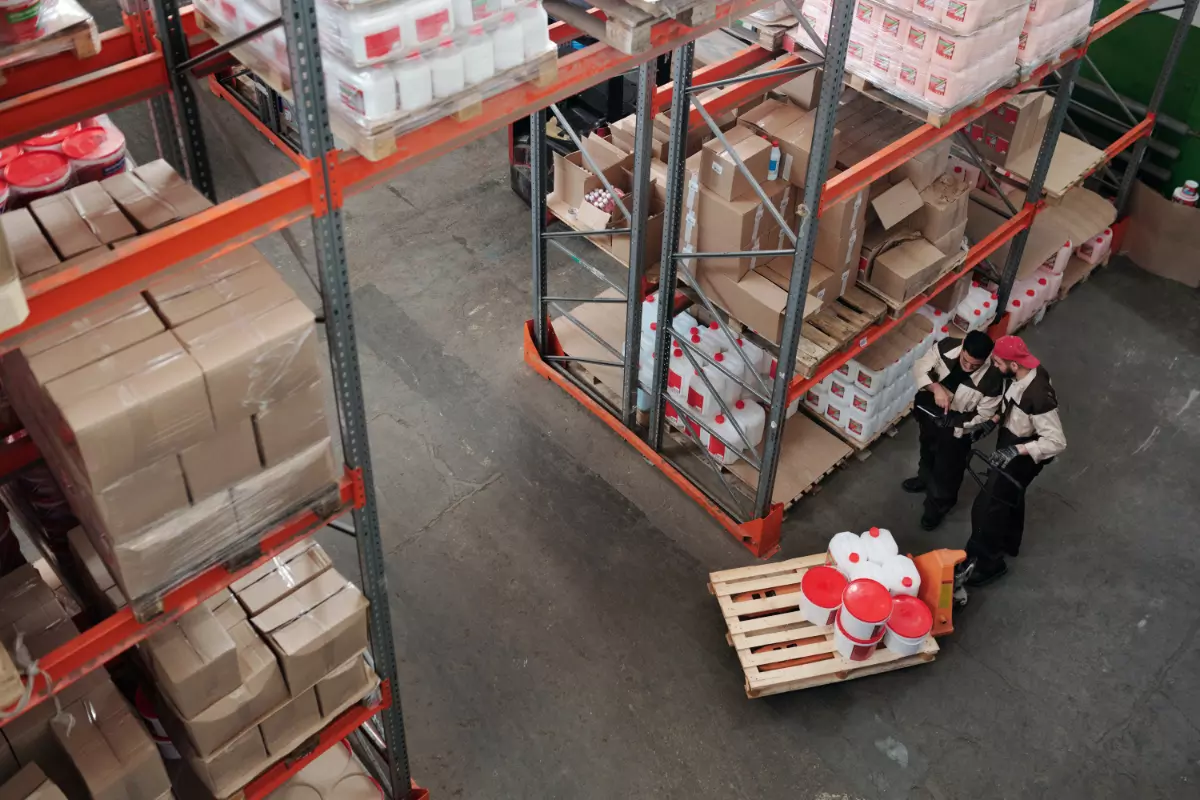How does a business deal with excess stock? We look at why a business can have excess stock and how to dispose of excess inventory.
What is excess inventory?
Excess inventory is also known as overstock and refers to items and goods that aren't the top sellers in your product line.
You haven't sold these goods and don't see any long-term profitability in them. Excess inventory is when you have too much inventory and is created when supply exceeds customer demand, leading to poor sales. This isn't always the business' fault and can also be caused by external factors.
Whether your business has a poor inventory management system with inaccurate forecasting and low turnover or you operate in an unpredictable market with great demand variability, excess products are always a risk.
In that case, it's common to find yourself holding excess inventory for long periods. But this isn't a good idea, as it will only be a burden to your company and lead to lower profit margins and extra expenses.
Why do businesses have excess stock?
In an ideal world, your supply would meet demand in a manageable way. Your supply chain processes should give you enough for your customers, with a little stock left over for shrinkage and not much more.
But making this a reality isn't easy. Getting your supply in tune with demand is a balancing act, with those too optimistic about their demand forecasting ending up with excess inventory.
Alternatively, it could be out of your control, with dramatic shifts in your market leading to excessive stock.
It's important to remember that excess inventory isn't just stock you're holding onto longer than usual before selling; it's stock you have to hold on to and don't anticipate recovering the storage and utility costs in the future.
The problem with excess inventory
If you can't move your stock through your regular sales channels, this excess inventory can quickly become a financial and cash flow hindrance.
One of the main disadvantages of excess items is the drain on your time and resources that could otherwise be spent more productively. However, the solution to this issue isn't an obvious one.
For example, you might consider holding a sale or trying to get rid of your excess inventory through specialist online sales. But these are almost the same as the sales channels that didn't work in the first place and are unlikely to solve your problem.
If you find that you're running out of space thanks to this excess stock, don't worry, there are several effective ways to reduce this burden.

What is the Difference Between Excess Stock and Dead Stock
Essentially, these two terms refer to the same thing. Excess stock that you don't think you'll never be able to recover the cost of is dead stock. You might also hear it referred to as obsolete inventory.
Does Slow-Moving Stock count as Excess Stock?
Whether slow-moving inventory is the same as excess or dead stock is a tricky determination. In some markets, most businesses with inventory that hasn't sold in the initial 90 days class it as slow, while stock they still have after three months is entirely dead.
But this depends on the market you work in and your inventory turnover. For example, outlets selling electronics may need to increase this time threshold for dead stock.

Alternatively, fashion retailers will reduce this threshold since a 90-day cycle would be an entire fashion season. Since styles change rapidly, it's almost impossible to avoid excess inventory in this industry.
However, remember that slow or stale inventory can also include excess stock. For example, you may be able to sell excess inventory, but you have so much you know you won't be able to sell everything, leading to excess stock in your warehouse.
How to Dispose of Excess Inventory
While there are several ways to reduce excess inventory, not every method will suit every business. Here are a few ways to reduce obsolete stock, so you can consider which might be the most appropriate for your business.
If you have a non-perishable stock and your supplier allows returns, you might want to consider sending it back to them. This allows you to free up some space and possibly recover some of the costs tied up in your excess inventory through refunds at a slightly lower price.
You don't always have to be in bitter competition with your competitors. Sometimes it's profitable to enter into a deal with them, supply them with what they are short on and possibly picking up stock you are low on. Alternatively, you can recoup some cash currently stuck in your dead stock. Not only will this solve your problem, but it'll help you build good relationships in your market.
Hosting a flash sale is a great way to get people to buy your excess inventory. Of course, you don't have to offer huge discounts, but the more excess stock you can sell, the better. You might think to bundle complementary products together in the hope of selling fast.
Alternatively, you might consider advertising coupons on your website landing pages to tell your customers you are hosting a sale. Alternatively, you can send coupons directly to customers through your social media or mailing lists. This is one of the best ways to reduce excess stock and save your company money.
Finding uses for excess stock in other areas of your business is a great way to make the most of what you have. Rather than simply throwing the excess stock away and losing all that value, reusing it elsewhere or re-marketing it helps you retain that value and still provide for your customers. It can also be cheaper than disposing of your dead stock since you might have to pay to remove it.
Letting a wholesaler sell your excess stock for a split of the profits is another great method of increasing your available warehouse space and recouping some of the costs of your excess inventory. There are two ways of doing this. Physical consignment means you send the stock to the wholesaler, while virtual consignment means you hold on to the stock and are responsible for shipping it when it is sold. But, by using another business' sales channels, you can take advantage of their particular market access and marketing budgets.
Inventory liquidators are another way to get rid of your excess inventory. However, they have to consider their own costs, so you won't be offered anywhere near a fair market price. Therefore, when companies sell their excess inventory to liquidators, they should weigh these costs against continuing to store their excess stock.
This method essentially removes the liquidator from the equation. The raw materials in your excess stock have some intrinsic value, which scrap dealers will pay you for if there's enough value. So it may be more beneficial to write off your stock and scrap it.
Of course, local charities and non-profit organisations are always looking for stock they can use. Charitable donations also come with the added benefit of being tax-deductible regarding your revenue, not to mention the publicity and marketing opportunities.
How to safely store surplus stock
Again, surplus inventory is always a risk whether you're a small independent business running operations from home or a large industrial manufacturer with giant warehouses. When you wind up with excess stock, it's important to store it properly. After all, it still has value that shouldn't be wasted. So, here are the best ways to deal with excess stock.
Count before moving stock
As a business, stock control is incredibly important, and it's crucial to know how much stock you have at all times. This is no different for your excess stock. Not only will this keep your books in order, but it allows you to provide accurate quotes for customers and suppliers. You can use excess inventory management software to make this easier.
Choose a dry and temperature-controlled location.
Dry locations with constant temperatures are the best places to store any excess inventory you have. Storage units are a fantastic option since they are usually temperature-controlled, secure environments to keep your inventory. You won't have to worry about damp or mould, so it will be in good condition when you can sell or dispose of the stock. Storage costs are also incredibly efficient for your business.
Select a location that is security managed
Once more, the value of your excess inventory is the main thing you want to maintain while you can't sell it. Therefore, having a secure place to store it is essential. Again, this is where storage units come in. With PIN-coded keypads, CCTV and human security, they have all the security measures you could want to keep your inventory safe.
Check sell-by dates
If your excess inventory comprises perishable goods with a set lifecycle, your inventory management team will want to plan ahead and check the sell-by dates before you store it. Not only will this help you organise your storage, such as keeping the excess goods that will expire sooner in more accessible places, but it will tell you how long you can store the inventory.
Look into insurance
While your inventory will be covered under your business insurance policy while on your premises, once you move it off-site, it may not be, so it's always best to check your insurance policy to see if you need additional cover.
Stack items correctly
Stacking inventory correctly may sound like an obvious suggestion, but it's essential to keeping your stock in good condition. Simple things like stacking lighter items on top of heavier ones, and not the other way around, will help keep your inventory safe. It will also help you make the most of your available shelf space, fitting more inventory wherever possible.
If you are looking for a reliable storage solution for your caravan, contact Blackmore Park Ltd at 01684 573693 . You'll get the best pricing and a range of customisable solutions.

